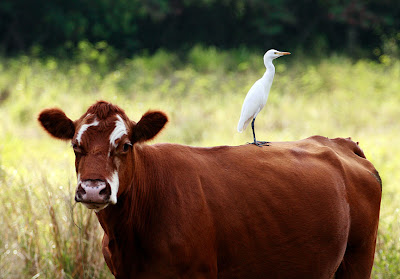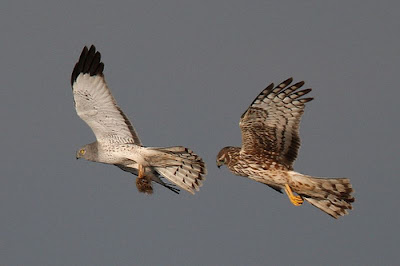February 27, 2009
Here Fishy, Fishy
Bird Strikes Fish In Water - Watch more Funny Videos
February 25, 2009
February 22, 2009
The envelope please...
And the award for best supporting bird goes to: The Cattle Egret
 "Oh, wow, I cannot believe this! I would like to thank the many water buffalo and cattle who allowed me to eat flies off their backs. What an honor! I'm glad I could keep you, the real stars of the story, tick-free. Sure, I'm sort of pretty. But I realize that I'm sort of a "poopy pastures" bird, while my cousin, the great egret, enjoys ocean views. No problem. This supporting award is everything I could hope for."
"Oh, wow, I cannot believe this! I would like to thank the many water buffalo and cattle who allowed me to eat flies off their backs. What an honor! I'm glad I could keep you, the real stars of the story, tick-free. Sure, I'm sort of pretty. But I realize that I'm sort of a "poopy pastures" bird, while my cousin, the great egret, enjoys ocean views. No problem. This supporting award is everything I could hope for."And the award for best costume goes to: The Painted Bunting
 "I've always felt I was the most brilliantly colored bird in North America, but it's an honor to be recognized by this little awards show. Really! And, I'm glad the academy could look past the fact that I'm highly territorial, often fighting other males to the death. They realize that it takes work to look this beautiful. To all my fans--you sad, little brown birds--please know how much I love you. Really! Oh, and XOXO to my agent. Really!"
"I've always felt I was the most brilliantly colored bird in North America, but it's an honor to be recognized by this little awards show. Really! And, I'm glad the academy could look past the fact that I'm highly territorial, often fighting other males to the death. They realize that it takes work to look this beautiful. To all my fans--you sad, little brown birds--please know how much I love you. Really! Oh, and XOXO to my agent. Really!"And the award for best score goes to: The Wood Thrush
 "Who could imagine that a little, brown bird from the backwoods could make it big like this?! Thank you so much. I have a bit of an advantage here, of course, with a song box that allows me to sing two notes at a time. Now, I hate to get political, but I ask you join me in fighting against the horrific nest parasitism of cowbirds. We must take a stand before they kill the wood thrush's beautiful song. Wait! Please don't play me off! Ooh, um, I want to thank my parents, my siblings, everyone who supported me in the meadow where I grew up...oh dear, I know I'm forgetting people! This has gone on far too long, hasn't it?" [awkwardly walks off stage]
"Who could imagine that a little, brown bird from the backwoods could make it big like this?! Thank you so much. I have a bit of an advantage here, of course, with a song box that allows me to sing two notes at a time. Now, I hate to get political, but I ask you join me in fighting against the horrific nest parasitism of cowbirds. We must take a stand before they kill the wood thrush's beautiful song. Wait! Please don't play me off! Ooh, um, I want to thank my parents, my siblings, everyone who supported me in the meadow where I grew up...oh dear, I know I'm forgetting people! This has gone on far too long, hasn't it?" [awkwardly walks off stage]And the award for best foreign language bird goes to: The Green Woodpecker
 Subtitles: "Merci, merci. I appreciate this opportunity to inform American citizens there are so many beautiful birds with lovely songs throughout the world. Sigh, none of you can understand me anyway, you uni-lingual buffoons. Your country could only hope to attain France's culture and beauty. You gorge on trash at McDonald's parking lots while I dine on delectable French ants. I cannot believe the cattle egret chose to move here. What? Another Die Hard sequel? Send the script to my vacation home in Orange County."
Subtitles: "Merci, merci. I appreciate this opportunity to inform American citizens there are so many beautiful birds with lovely songs throughout the world. Sigh, none of you can understand me anyway, you uni-lingual buffoons. Your country could only hope to attain France's culture and beauty. You gorge on trash at McDonald's parking lots while I dine on delectable French ants. I cannot believe the cattle egret chose to move here. What? Another Die Hard sequel? Send the script to my vacation home in Orange County."And, finally, the award for best bird goes to: The Yellow-headed Blackbird
 "This award has been a long time in coming, believe me. First, let me thank my sponsor, the Your Bird of the Week blog. You've always supported me, even in the face of bigger and more pretentious birds. I'd also like to thank my eight wives and 30 children (at least this season), who are back in the marsh watching this. Make daddy proud and harass a few marsh wrens before you go to bed. I'll be home in Utah to celebrate with you soon!"
"This award has been a long time in coming, believe me. First, let me thank my sponsor, the Your Bird of the Week blog. You've always supported me, even in the face of bigger and more pretentious birds. I'd also like to thank my eight wives and 30 children (at least this season), who are back in the marsh watching this. Make daddy proud and harass a few marsh wrens before you go to bed. I'll be home in Utah to celebrate with you soon!"Well, I'm not Hugh Jackman, but I felt like a bit of a celebrity myself last week on the Birdchick blog. So, as your Birding Oscars host, I want to thank my husband, Tim, for his willingness to pretend to be interested with this geeky avian stuff. Now, we're off to the after-parties. Good night everyone! Kiss, kiss.
Was your favorite bird totally robbed? Nominate it in comments.
Photo credits
Cattle egret: Honolulu Star Bulletin
All other photos: Wikimedia Commons
February 18, 2009
Welcome Birdchick Readers!
February 17, 2009
Little Dipper
Fact: The American dipper is a chunky, dark gray songbird with short wings and tail and a large head. It has white eyelids t hat are quite obvious when it blinks.
hat are quite obvious when it blinks.
Fact: The American dipper is named for its habit of dipping—basically bending its legs and bouncing its body up and down. Now whether this is a nervous tic like my pen tapping or necklace twisting, scientists really aren’t sure. But dippers do tend to dip more when disturbed, approached by humans, or even aroused.
Fact: Don’t be fooled by its anxious habits or monastic garb. The American dipper has extreme skills for a little songbird. It makes its life in rushing mountain streams, literally riding the rapids and walking along icy streambeds to find food.
Fact: The American dipper has nasal flaps to help prevent water from entering its nostrils, large glands that produce its very own waterproofing oil, and strong eye muscles that help it see underwater. This is a great video to show you what the dipper does underwater. (It's professionally produced by National Geographic.) Twenty or 30 seconds should give you a good idea.
Fact: Just what is the American dipper seeking at the bottom of those icy streams? Mostly insects and insect larvae, and occasionally tiny fish and fish eggs.
Fact: American dippers build nests of moss and grass right alongside streams, but they need places that aren’t threatened by flooding, are inaccessible to predation, and have some sort of horizontal support. The undersides of bridges are a popular spot.
Fact: Both parents usually feed the nestlings after they hatch. Within 16 days, nestlings can dive, swim, and pull themselves out of the water.
Fact: Perhaps in an attempt to utilize limited resources, parents will sometimes split up, each taking half of the nestlings to establish their own territory. No weekend visitations, here. Once territories are established, the once happy family will rarely cross any unmarked borders.
Fact: I’ve gone on too long about the American dipper (because it's so cool). But, if you’ve read all the way to the end, congratulations!
This has been Your BOTW!
February 3, 2009
What Happens on the Way to Wendover...
I am considerably unlucky when it comes to gambling, but I counted myself a lucky birder on the drive to Wendover when I saw a very cool bird at 80 mph. (I was the one going 80 mph, just so we’re clear.) The bird was heading east along the side of the freeway as we were traveling west. It was a hawk, and I’m usually not so great at identifying those. But this hawk was different. Even while passing it at 80 mph, the way it was flying—and where it was flying—were pretty big clues. And then, I looked in the rearview mirror and saw its very distinctive rear end and knew—it was Your BOTW, the Northern harrier.
Fact: The Northern harrier is a medium-sized hawk with long wings and a long tail and a bright, white rump. (So bright and white, you could see it in a rearview mirror on the freeway.) Now, we need to get into coloring at this point, but that brings me to one of the reasons harriers are unique…
Fact: The Northern harrier is one of the few hawks in which the sexes look very different. They share similar body shapes and that distinct white rump, but the male has a light gray back and hood while the female is a dark, mottled brown. The female is also considerably bigger. This great photo I found on Flickr shows just how different they look. The male, which is sometimes referred to as the "gray ghost," is in the front. (We passed a male, if you were wondering. You totally weren’t though, huh?)
Fact: If you get a chance to see a Northern harrier for longer than three seconds, you’ll notice it has stiff feathers around its face known as facial disks (making its head look much like an owl). These facial disks help it listen for prey in fields and undergrowth. (Most hawks just hunt by sight.)
Fact: Now, if a bird uses hearing to help locate prey, you know it’s not going to be 100 or 200 feet in the air while it’s hunting. (This was my first clue in identifying my Wendover bird.) The Northern harrier flies extremely low to the ground, often over fields and marshes, in a very distinct, slow glide, occasionally wheeling sharply. It will even hover before pouncing on prey. This video captures its beautiful flight very well, so please forgive the music. (Most videos out on YouTube and elsewhere could barely keep up with these birds. Please be patient if this takes a while to load.)
Fact: The Northern harrier mostly hunts rodents, like field mice and voles, but it is also known to take small songbirds and waterfowl.
Fact: A duck is a lot bigger than a field mouse, obviously, so harriers sometimes deal with the size issue by drowning a duck before taking it.
Fact: The Northern harrier is often a polygynous breeder, with up to five or six females breeding with a single male. (Another fact that makes harriers unique among hawks.)
Fact: The male Northern harrier will attempt to take care of his entire harem throughout the egg laying and incubation process, bringing food to all of the females and their young after hatching. Fortunately for him, female Northern harriers in a single harem will generally nest close to each other.
Fact: The male Northern harrier attracts his mate or mates by performing an elaborate sky-dancing display. He will also often give the female a gift of food right before copulation.
Fact: The Northern harrier nests on the ground in tall, dense clumps of vegetation. It will defend its nest if you get too close by giving a high-pitched kek and/or diving at your head.
Fact: According to the Nevada Gaming Commission, the average slot machine payout last year was 94%. According to my calculations, the average payout for any slot machine I play is about 3%. According to common sense, the fact that I continue to gamble despite those odds is sort of stupid. According to my calendar, I plan to return to Wendover in early July.
This has been Your BOTW.







